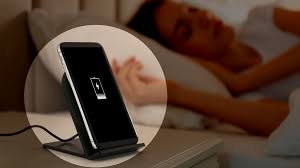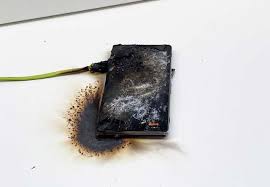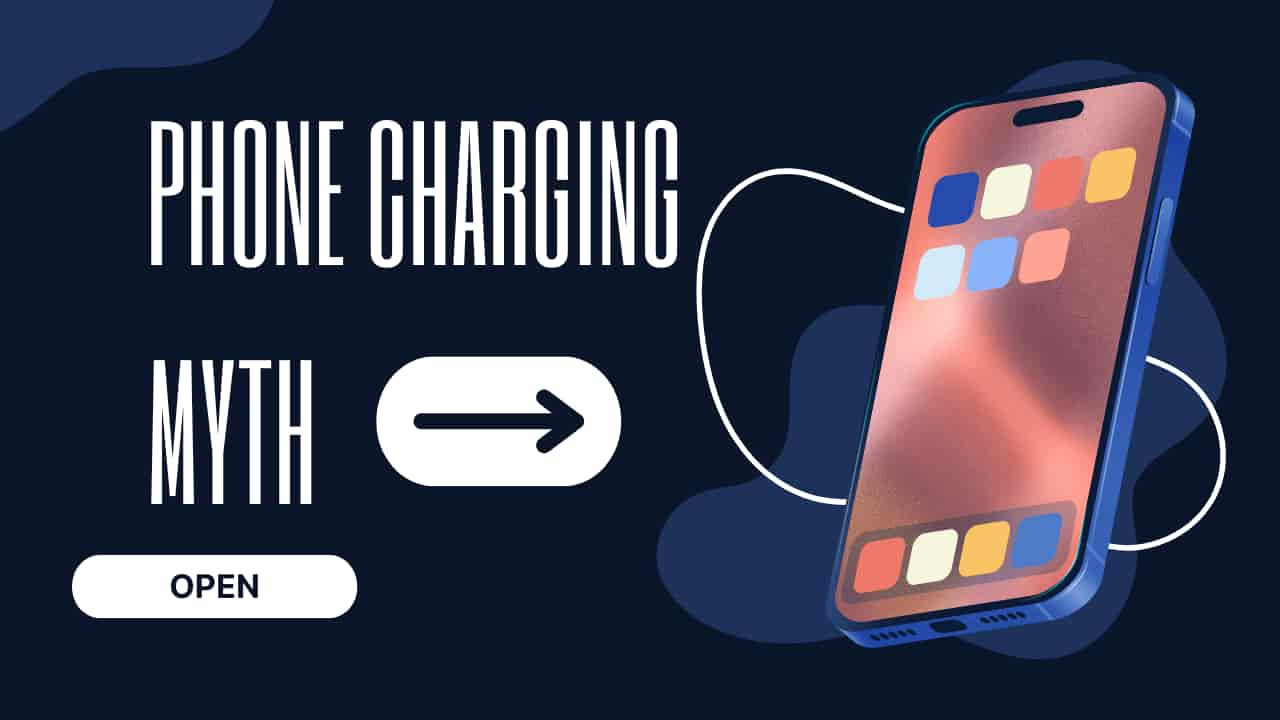Myth 1: Overnight Charging Kills Batteries
Why Do We Believe This phone charging myth?
The idea that leaving your phone plugged in all night will destroy its battery is one of the most persistent phone charging myth. It’s like the tech equivalent of “don’t swim after eating.” This belief has its roots in older battery technology. Back in the 90s and early 2000s, devices often used nickel-cadmium (NiCd) or nickel-metal hydride (NiMH) batteries.
These batteries suffered from a “memory effect,” where repeated partial charges could reduce their capacity. Overcharging was also a real issue, as primitive chargers didn’t know when to stop pumping power, leading to heat buildup and battery degradation.
Fast forward to today, and smartphones use lithium-ion batteries, which are far smarter and more resilient. Modern phones come with built-in battery management systems that act like a vigilant bouncer at a club: once the battery hits 100%, the charger is politely told, “No more juice for you.” The phone then sips tiny amounts of power to maintain its charge, a process called trickle charging. According to Battery University, this system prevents overcharging, making overnight charging generally safe.
The Heat Factor
But here’s where things get a bit tricky. While overcharging isn’t a concern, heat is a lithium-ion battery’s kryptonite. Charging generates warmth, and if your phone is nestled under a pillow, wrapped in a thick case, or sitting in a hot room, prolonged exposure to heat can stress the battery.
Over time, this can reduce its capacity, meaning your phone might not hold a charge as long as it used to. A 2023 study by the University of Michigan found that consistent exposure to temperatures above 35°C (95°F) during charging can cut a battery’s lifespan by up to 20% over two years.
Does this mean you need to set an alarm to unplug your phone at 3 a.m.? Not quite. Most phones are designed to handle occasional overnight charging without significant harm. However, if you’re charging in a sauna-like environment or your phone feels like a hot potato, it’s time to rethink your setup.
Truth Behind the phone charging myth
Mostly false. Overnight charging won’t “kill” your battery thanks to smart charging systems, but heat can cause gradual damage. To play it safe, charge in a cool, well-ventilated spot and avoid smothering your phone with blankets or cases. Curious about other ways to pamper your battery? Check out our battery care tips for more insights.
Myth 2: Only Use Original Chargers
Where Did This Myth(phone charging myth) Come From?
Raise your hand if you’ve ever lost your phone’s original charger and felt a pang of dread, convinced that a third-party replacement would wreak havoc on your device. This phone charging myth is fueled by a mix of cautionary tales and clever marketing by phone manufacturers. After all, who wouldn’t want you to buy their $40 proprietary charger? The fear is that non-original chargers might deliver the wrong voltage or amperage, frying your phone’s internals or, at the very least, slowing down the charging process.
There’s some truth to this concern. Back in the early days of smartphones, chargers were less standardized, and cheap knockoffs could indeed cause problems. Faulty chargers might lack proper power regulation, leading to overheating, battery damage, or even fire hazards. A 2019 report by the Electrical Safety Foundation International highlighted that counterfeit chargers were linked to dozens of house fires annually.
Read more: Supercharge Your Old Android Phone’s Speed- Best Tip 2025
The Reality of Third-Party Chargers
Thankfully, the charging landscape has evolved. Today, reputable third-party chargers from brands like Anker, Belkin, or Aukey are designed to meet strict safety standards like USB-IF (USB Implementers Forum) or MFi (Made for iPhone). These certifications ensure that the charger delivers the right power output for your device, making them just as safe as the original. A 2023 study by CNET tested certified third-party chargers over six months and found no significant battery degradation compared to original chargers.
That said, not all third-party chargers are created equal. Those $2 cables from a shady online marketplace? They’re a gamble. Poorly made chargers might skimp on safety features, leading to inconsistent power delivery or, worse, electrical shorts. The key is to stick with trusted brands and check for certifications. Also, keep an eye on your cable’s condition—frayed or damaged cables can cause charging issues or pose safety risks.
Truth Behind this phone charging myth
Partially true. Original chargers are reliable, but certified third-party chargers are just as safe and often more affordable. Avoid cheap, unbranded options, and you’ll be fine. Want to learn how to spot a safe charger? Our guide on choosing safe chargers has you covered.

Myth 3: Charging to 100% Is Harmful
Why Does This Myth(phone charging myth) Persist?
You’ve probably heard that charging your phone to 100% is like forcing it to run a marathon every day—it’ll wear out faster. This phone charging myth has a kernel of truth, rooted in the science of lithium-ion batteries. These batteries have a limited number of charge cycles, typically 300–500, before their capacity drops to around 80%. A charge cycle is counted when you’ve used and recharged 100% of the battery’s capacity, though not necessarily in one go.
Charging to 100% and keeping it there, especially in warm conditions, can stress the battery’s chemical structure, accelerating wear. This is because lithium-ion batteries are happiest at partial charge states, ideally between 20–80%. A 2022 study by the Journal of Electrochemical Society noted that batteries kept at 100% charge for extended periods lost capacity 10% faster than those maintained at 50% over a year.
Smart Tech to the Rescue
Before you start obsessively unplugging your phone at 80%, know that modern smartphones are way ahead of you. Many devices, like iPhones and high-end Androids, feature “optimized battery charging” settings. For example, Apple’s iOS learns your charging habits and delays charging past 80% until you’re likely to unplug, reducing time spent at 100%. Samsung and Google offer similar features, capping charge levels or slowing charging as the battery nears full.
Even without these settings, occasional 100% charges won’t spell disaster. The impact is cumulative and depends on factors like heat and charging frequency. If you’re charging in a cool environment and not hitting 100% every single day, the effect is minimal. Plus, manufacturers design batteries to last several years under typical use, so you’re unlikely to notice significant degradation before upgrading your phone.
Truth Behind this phone charging myth
Partially true. Frequent 100% charges can slightly reduce battery lifespan, but smart charging features and proper care minimize the impact. Want to keep your battery in top shape? Dive into our battery optimization guide for pro tips.
Myth 4: Fast Charging Ruins Batteries (phone charging myth)
The Fast Charging Frenzy
Fast charging is the superhero of the smartphone world, swooping in to save you when your battery’s at 5% and you’re late for a meeting. But some worry it’s a villain in disguise, secretly sabotaging your battery. This phone charging myth stems from the fact that fast charging pushes more power into the battery in less time, generating extra heat. As we’ve established, heat is no friend to lithium-ion batteries.
A 2024 report by Android Authority found that fast charging can reduce battery capacity by 1–2% more per year compared to standard charging. The faster the charging speed (think 65W vs. 15W), the more heat is produced, which can stress the battery’s chemical components over time. This effect is more pronounced if you’re fast charging in a hot car or under direct sunlight.
Built-In Safeguards
Before you swear off fast charging forever, know that phone manufacturers aren’t throwing caution to the wind. Brands like OnePlus, Xiaomi, and Apple design fast charging systems with advanced cooling mechanisms and power regulation. For example, many phones use multi-cell batteries or vapor chambers to dissipate heat, while chargers adjust power delivery based on the battery’s state. Some devices even slow down charging as the battery nears 100% to reduce stress.
The key is moderation. Using fast charging occasionally, especially when you’re in a pinch, is unlikely to cause noticeable harm. But relying on it daily, particularly in warm conditions, could shave a bit off your battery’s lifespan. Mixing fast and standard charging, and keeping your phone cool, strikes the perfect balance.
Read more: What is about phone charging myth?
Truth Behind this phone charging myth
Partially true. Fast charging has a minor impact on battery health, but built-in safeguards and smart usage keep risks low. Want to master fast charging? Our fast charging guide has all the details.
Myth 5: Don’t Use Phone While Charging due to phone charging myth
Where Did This Fear Start?
Ever been told not to text, scroll, or play games while your phone’s plugged in? This phone charging myth likely originated from rare but sensationalized stories of faulty chargers causing electric shocks or fires. In the early days of mobile phones, low-quality chargers and cables could indeed pose risks, especially if they were damaged or poorly insulated. These horror stories stuck, creating a lingering fear that using a charging phone is inherently dangerous.
Another factor is the misconception that using your phone while charging overworks the battery, leading to faster wear. Some even believe it could cause the phone to overheat or explode—a dramatic exaggeration that’s more Hollywood than reality.
The Truth About Multitasking
Here’s the good news: using your phone while it’s charging is perfectly safe, provided you’re using a certified charger and cable. Modern smartphones are designed to handle multiple tasks, including charging and running apps simultaneously. The charging process is managed by the phone’s hardware, which prioritizes safety and efficiency. A 2023 safety report by UL Solutions confirmed that certified chargers pose no significant risk during normal use, even under heavy workloads.
There are a couple of caveats, though. Using your phone for power-intensive tasks, like gaming or streaming, while charging can slow down the charging speed, as the phone diverts some power to the screen and processor. It can also generate extra heat, which, as we’ve discussed, isn’t great for battery health. Keeping your phone in a cool environment and avoiding marathon gaming sessions while plugged in will keep things running smoothly.
Truth Behind this phone charging myth
Mostly false. It’s safe to use your phone while charging with certified equipment, though heavy use may generate heat or slow charging. For more on staying safe, check our phone safety tips.

Tips to Optimize Phone Charging due to phone charging myth
Now that we’ve debunked the top phone charging myth, let’s talk about how to charge your phone like a pro. These tips will help you maximize battery life, stay safe, and make the most of your device’s charging capabilities:
- Use certified chargers and cables: Look for USB-IF or MFi certifications to ensure safe and efficient charging. Avoid cheap, unbranded options that could damage your phone.
- Keep your phone cool: Charge in a well-ventilated area, away from blankets, pillows, or direct sunlight. Remove thick cases during charging to prevent heat buildup.
- Enable optimized charging: Turn on your phone’s battery management settings, like Apple’s Optimized Battery Charging or Samsung’s charging limits, to reduce wear.
- Avoid deep discharges: Try not to let your battery drop to 0% frequently, as this can stress the battery. Aim to recharge when it’s around 20%.
- Mix charging speeds: Use fast charging when you’re in a hurry, but rely on standard charging for daily use to minimize heat and stress.
- Check cable condition: Inspect your charging cables regularly for fraying or damage, which can cause inefficient charging or safety hazards.
- Update your software: Manufacturers often release updates that improve battery management, so keep your phone’s operating system up to date.
| Do | Don’t |
|---|---|
| Use certified chargers | Use cheap, unbranded chargers |
| Charge in a cool place | Charge under pillows |
| Enable battery optimization | Always charge to 100% |
| Inspect cables regularly | Use damaged cables |
Frequently Asked Questions
1. Does overnight charging damage my phone due to phone charging myth?
Modern phones have smart systems that prevent overcharging, making overnight charging safe. However, heat can harm batteries, so charge in a cool, ventilated area to maintain long-term battery health.
2. Can I use any charger for my phone?
Stick to certified chargers (USB-IF or MFi) from reputable brands. They match your phone’s power needs and are safe. Cheap, unbranded chargers can cause damage or pose fire risks.
3. Is fast charging bad for battery life?
Fast charging generates heat, which can slightly reduce battery lifespan over time. Modern phones have safeguards, so use fast charging sparingly and in cool conditions for best results.
4. Should I avoid charging to 100%?
Occasional 100% charges are fine, but frequent full charges can stress batteries. Enable optimized charging features to keep your battery between 20–80% for maximum longevity.
5. Is it safe to use my phone while charging and what about phone charging myth?
Yes, it’s safe with certified chargers and cables. Heavy use like gaming may slow charging or generate heat, so keep your phone cool to protect battery health.
Uncover the truth behind phone charging myth! Learn which beliefs hold up and how to charge smarter in this fun, fact-filled guide. Read now!


Этот информативный материал предлагает содержательную информацию по множеству задач и вопросов. Мы призываем вас исследовать различные идеи и факты, обобщая их для более глубокого понимания. Наша цель — сделать обучение доступным и увлекательным.
Подробнее можно узнать тут – https://vyvod-iz-zapoya-1.ru/